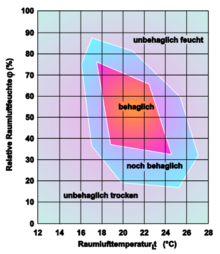comfort
Comfort is a term for a physical and mental state of subjective well-being in relation to the indoor climate. It is characterized by a state of minimal thermoregulation, in which the heat production of the organism is in a balanced relationship to the heat release into the air. In today's parlance, it is often used synonymously with coziness or comfort. - A definition of the 19th century reads: “a persistently pleasant sensation, especially satisfaction with the present, painful and carefree conditions. "
In heating and air conditioning technology , comfort refers to the air condition range in which room users feel comfortable and do not require any change in the room climate. Since people perceive comfort subjectively and every person has their own preferences for the room climate, there is a comfort range of room air temperature and relative room air humidity in which the vast majority of room users feel comfortable. As shown in the figure, this zone extends from around 18 ° C to 24 ° C and 35% to 75% relative humidity. Indoor air quality and thermal comfort , which is limited to the design and arrangement of radiators, are sub-themes of the term comfort .
The main factors of comfort are those that influence the equilibrium of the person's heat balance. This includes air movement, humidity, air and wall temperature as well as the activity and clothing of the room user. Since stronger air movements in closed rooms are perceived as unpleasant drafts , the air movement in rooms must be reduced to a minimum, although similar air movements in the great outdoors can be considered pleasant. Irregular, turbulent air movements are particularly annoying. The absolute humidity should be between 5 and 12 g / kg air for comfort ; For the relative humidity, this means that it has to decrease as the temperature rises.
The room air temperature perceived as comfortable is not only dependent on the relative humidity, as shown in the figure, but the season, age and gender of the person also have an impact on their level of comfort, as does the person's activity and the choice of clothing.
Overall, there are other factors that have an impact on comfort. They can be divided into thermal, non-thermal and personal factors.
- Thermal factors
• Room air temperature • Outside air temperature • Temperature of the surrounding surfaces • Air humidity • Air speed • Turbulence of air movement
- Non-thermal factors
• Season • Airborne noise • CO 2 content of the air • Content of perceptible trace substances • Content of harmful components (gases, vapors, radioactive substances) • Content of biological substances (fungi, bacteria) • Irritation from people • Odors
- Personal factors
• Age • Clothing • Physical activity • Length of stay • Physical and mental health
literature
- Hermann Recknagel, Eberhard Sprenger, Rudolf Schramek (eds.): Pocket book for heating and air conditioning . 68th edition. R. Oldenbourg Verlag , Munich, Vienna 1997, ISBN 3-486-26214-9 , pp. 50-61 .
